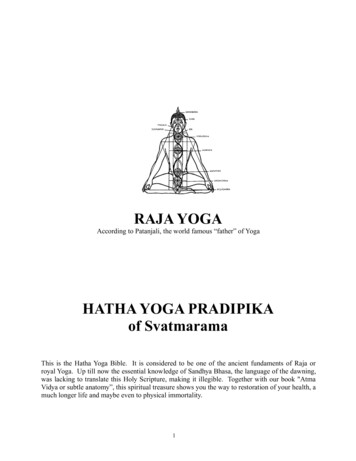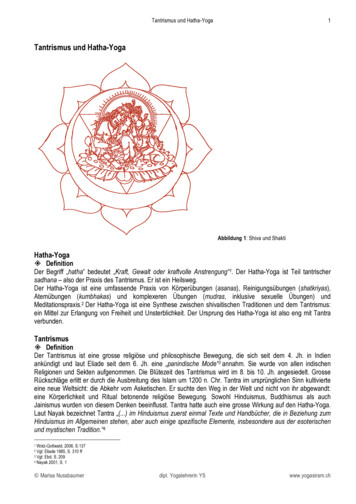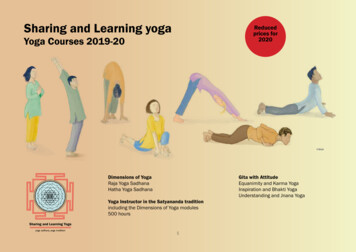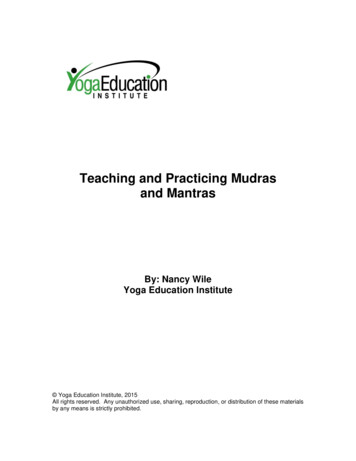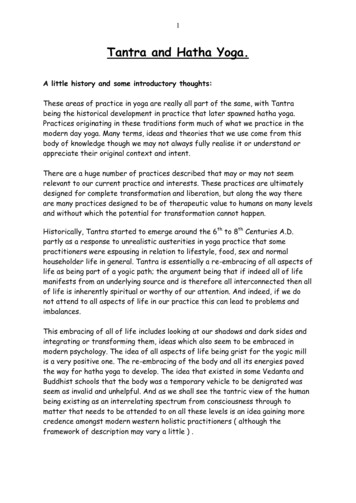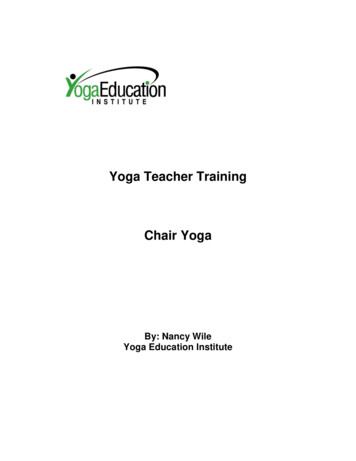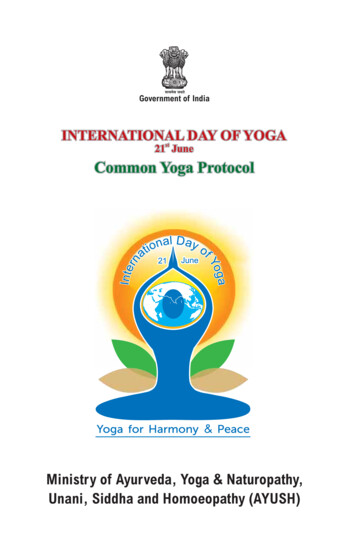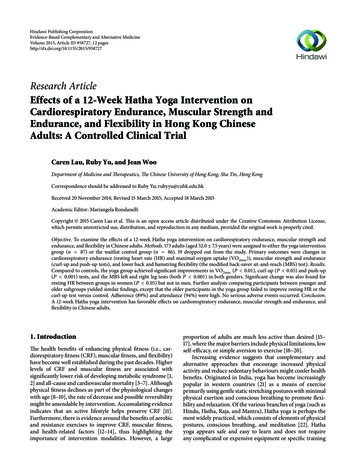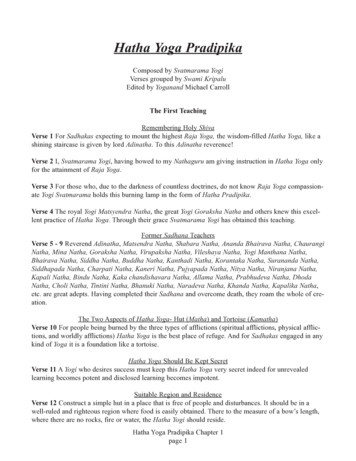
Transcription
Hatha Yoga PradipikaComposed by Svatmarama YogiVerses grouped by Swami KripaluEdited by Yoganand Michael CarrollThe First TeachingRemembering Holy ShivaVerse 1 For Sadhakas expecting to mount the highest Raja Yoga, the wisdom-filled Hatha Yoga, like ashining staircase is given by lord Adinatha. To this Adinatha reverence!Verse 2 I, Svatmarama Yogi, having bowed to my Nathaguru am giving instruction in Hatha Yoga onlyfor the attainment of Raja Yoga.Verse 3 For those who, due to the darkness of countless doctrines, do not know Raja Yoga compassionate Yogi Svatmarama holds this burning lamp in the form of Hatha Pradipika.Verse 4 The royal Yogi Matsyendra Natha, the great Yogi Goraksha Natha and others knew this excellent practice of Hatha Yoga. Through their grace Svatmarama Yogi has obtained this teaching.Former Sadhana TeachersVerse 5 - 9 Reverend Adinatha, Matsendra Natha, Shabara Natha, Ananda Bhairava Natha, ChaurangiNatha, Mina Natha, Goraksha Natha, Virupaksha Natha, Vileshaya Natha, Yogi Manthana Natha,Bhairava Natha, Siddha Natha, Buddha Natha, Kanthadi Natha, Korantaka Natha, Surananda Natha,Siddhapada Natha, Charpati Natha, Kaneri Natha, Pujyapada Natha, Nitya Natha, Niranjana Natha,Kapali Natha, Bindu Natha, Kaka chandishavara Natha, Allama Natha, Prabhudeva Natha, DhodaNatha, Choli Natha, Tintini Natha, Bhanuki Natha, Naradeva Natha, Khanda Natha, Kapalika Natha,etc. are great adepts. Having completed their Sadhana and overcome death, they roam the whole of creation.The Two Aspects of Hatha Yoga- Hut (Matha) and Tortoise (Kamatha)Verse 10 For people being burned by the three types of afflictions (spiritual afflictions, physical afflictions, and worldly afflictions) Hatha Yoga is the best place of refuge. And for Sadhakas engaged in anykind of Yoga it is a foundation like a tortoise.Hatha Yoga Should Be Kept SecretVerse 11 A Yogi who desires success must keep this Hatha Yoga very secret indeed for unrevealedlearning becomes potent and disclosed learning becomes impotent.Suitable Region and ResidenceVerse 12 Construct a simple hut in a place that is free of people and disturbances. It should be in awell-ruled and righteous region where food is easily obtained. There to the measure of a bow’s length,where there are no rocks, fire or water, the Hatha Yogi should reside.Hatha Yoga Pradipika Chapter 1page 1
Characteristics of a Yoga ResidenceVerse 13 Accomplished masters of Hatha Yoga have given this description of a Yoga residence. Itshould have a small door, no windows or leaks, neither too high or low, with an even floor, wellsmeared with cow-dung and free from insects. It should be adorned outside with a porch and a well. Awall should protect it.InstructionVerse 14 Having taken residence in such a place the Sadhaka, free from concerns, must unceasinglypractice Yoga according to the directions of his Guru.The Six EnemiesVerse 15 Through overeating, overexertion, talkativeness, stubborn persistence regarding disciplines,the company of people, and fickleness, Yoga is lost.The Six FriendsVerse 16 With enthusiasm, courage, perseverance, discrimination, unshakable faith, and abandonmentof the company of people, Yoga is accomplished in the highest way.Asana (posture)Verse 17 The first part of Hatha teaching is Asana so it is spoken of first of all. By means of its practice the practitioner receives steadiness, freedom from disease, and lightness of limbs.Remarks of Previous Sadhana TeachersVerse 18 Vasishtha and other wise men and Matsyendra Natha and other Yogis have approved of certain Asanas. I too approving certain Asanas will describe them.SwastikasanaVerse 19 The Sadhaka should sit with the soles of both feet properly placed between the thighs and thecalves. Yogis call this posture the Asana of the Swastika.GomukhasanaVerse 20 Placing the ankle of the right foot under the left buttock and the ankle of the left foot underthe right buttock makes an Asana resembling the shape of a cow’s face. It is called Gomukasana.VirasanaVerse 21 To firmly place the feet on opposite thighs is called the ‘virile posture.’KurmasanaVerse 22 Turn the feet outward and press the anus with the two heels. To sit this way is called ‘tortoiseposture’ by the Yogis.KukkutasanaVerse 23 Sit in Padmasana and slip both hands in between the calves and the thighs to place themfirmly on the ground. Then raise the body upward. This is called ‘cock posture.’Hatha Yoga Pradipika Chapter 1page 2
Uttana KurmasanaVerse 24 The Sadhaka should bind himself in cock posture. Then bringing both feet to the chest andgrasping the neck with both hands he should remain sitting like an upturned tortoise. This is calledUttana Kurmasana.DhanurasanaVerse 25 Grasping the big toes of both feet with both hands and pulling one foot up to the ear likedrawing a bow is called ‘bow posture.’MatsyendrasanaVerse 26 Place the right foot at the base of the left thigh and the left foot on the outside of the right hip.Twisting the body in the opposite direction is the Asana described by the royal Yogi Matsyendra Natha.The Revealed Result of MatsyendrasanaVerse 27 Matsyendrasana lights the fire in the belly. Like a sharp-pointed weapon it massacres theaggregate of disease and makes steady the Sadhaka’s moon. By its practice the Kundalini Shakti isaroused.PashchimotanasanaVerse 28 Stretch out both feet like a staff and grasp the big toes with both hands. Place the forehead onthe knees and stay in this position. This is called ‘back stretch posture.’Verse 29 Accomplishing this foremost Pashchimotanasana makes the Prana a traveler on the middlepath. It ignites the fire in the belly and having made the abdomen lean, renders the Sadhaka diseasefree.MayurasanaVerse 30 Taking support of the earth with both hands and placing the two elbows alongside the navel,raise up high from the earth like a stick. That Asana is called ‘peacock posture.’Result of MayurasanaVerse 31 Mayurasana rapidly destroys all diseases of the glands, abdomen, etc. and balances thehumors of Vata and Pita. Stimulating the fire in the belly it completely digests all stale, dirty, and indiscriminate food. It digests even the Kalakuta poison.ShavasanaVerse 32 To lie out straight on the earth like a corpse is ‘corpse pose.’ This Asana is the reliever offatigue and the bringer of peace to the Chitta.Verse 33 Beloved lord Shiva has described eighty-four Asanas, but taking only four I describe them.The Four Highest AsanasVerse 34 Of all the Asanas, Siddhasana, Padmasana, Sinhasana, and Bhadrasana, are the very highest.And of these one should be ever steady in the pleasure giving Siddhasana.Verse 35 Firmly block the perineum with one heel and press the other heel against the Linga. Thenpress the chin against the chest and sit very steadily controlling the organs. Finally, one should lookwith a steady gaze toward the middle of the brow. The opener of the door of the path of liberation, thisAsana is called ‘posture of the adepts.’Hatha Yoga Pradipika Chapter 1page 3
Verse 36 Placing one heel above the Linga and the other on top of that is Siddhasana according toothers.Verse 37 This Asana some Yogis call ‘Siddhasana,’ some ‘Vajrasana.’ Other Yogis call it ‘Muktasana,’or ‘Guptasana.’Praise of SiddhasanaVerses 38 - 43 Just as Siddha Yogis consider moderation in diet to be foremost among the Yamas andnon-violence chief among the Niyamas, so they consider Siddhasana to be the chief among the Asanas.It is advisable that among the eighty-four Asanas, the Sadhaka seeking liberation practice Siddhasanabecause it cleanses the impurities of the 72,000 Nadis. If the Yogi meditating on Atman and eating moderately does repeated practice of Siddhasana for twelve years continuously he obtains Yogic powers.After Siddhasana what is the use of other Asanas? When with alertness the restrained Prana is transformed into Kevala Kumbhaka, then the Unmani stage is effortlessly generated of its own accord.When Siddhasana is accomplished Tribandha also is born in a natural way. There is no Asana likeSiddhasana, no Kumbhaka like Kevala Kumbhaka, no Mudra like Khechari Mudra, and no Laya likeNada.PadmasanaVerse 44 Place the right foot on the left thigh and the left foot on the right thigh. Hold the two big toeswith the opposite hands crossed around the back. Lodge the chin on the chest and gaze unblinking atthe tip of the nose. This destroyer of the diseases of the Samyami is called ‘lotus posture.’Padmasana and Another OpinionVerse 45 - 47 With special attention place both feet soles up on the thighs. Place both hands palms upbetween them and fix the attention on the tip of the nose. Press the two front teeth with the tongue andlodge the chin on the chest. Little by little attract the Prana upward. The Asana so formed is said to bethe destroyer of all diseases. It is difficult to achieve and can only be learned from someone who hasrare understanding.Knowledge Generation and PadmasanaVerse 48 Sit in Padmasana with the chin pressed on the chest and the two cupped palms joined. TheSadhaka meditating on the adored one should again and again attract the Apana upward and the Pranadownward. By the power of Shakti he gets incomparable knowledge.The Characteristics of a Liberated YogiVerse 49 The Yogi sitting in Padmasana who makes the Vayu drawn into the Nadi completely steady inthe brain is liberated. In this there is no doubt.SinhasanaVerses 50 - 52 Place both heels behind the scrotum on the sides of the perineum, left heel on the rightside and right heel on the left side. Place the two hands on the two knees. Spread the fingers and openthe mouth. Extend the tongue as far as possible and with one-pointed Chitta focus the gaze at the tip ofthe nose. This highest lion pose, most valued by Yogis, accomplishes Tribandha.Hatha Yoga Pradipika Chapter 1page 4
BhadrasanaVerses 53 - 54 Place the two heels below the scrotum on the sides of the perineum, left heel on the leftside and right heel on the right side. Then hold the two feet very firmly with both hands. This isBhadrasana, destroyer of all diseases. Some Siddha Yogis call this Gorakshasana.Sadhana of Hatha YogaVerses 55 – 57 Becoming free from fatigue by practicing Asanas, the chief of Yogis should repeatedlypractice Nadi purification, Kriyas, Pranayama and Mudras. The practice of Hatha Yoga is in this order:Asana, Kumbhaka, Mudra, and Nadanusandhana.The Time LimitVerse 58 A renunciate Brahmachari who takes measured food and who has Yoga as his last resortbecomes a Siddha in one year. In this there is no doubt.Wholesome, Measured FoodVerse 59 Eating smooth (unctuous) sweet food taken to please Shiva, with one-fourth of the stomachleft empty is Mitahara or Yuktahara (appropriate food).Unsuitable FoodVerses 60 - 61 Yogis consider the following foods to be unsuitable: bitter, sour, pungent, salty, hot,unripe vegetables, fermented barley grain, oil, sesame, mustard, intoxicating drink, fish, meat of goatand other animals, curdled milk, buttermilk, broad bean, Jujube, oil cakes, Asafoetida, garlic, etc. Foodheated a second time, harsh, excessively salty or sour is to be abandoned. During the time of repeatedpractice the Sadhaka should not serve the fire, associate with women, go on journeys, etc.Suitable FoodVerses 62 - 63 Wheat, rice, barley, Shashtika (a kind of quick growing rice), milk, clarified butter, treacle molasses, fresh butter, sugar candy, honey, dry ginger and the five leafy vegetables, mung beans,and crystal clear water are suitable for Yogindras. The Yogi should take food which is nourishing,sweet, agreeable, combined with milk, etc., supporting the Dhatus, desired in the heart, and fit for Yoga.The Greatness of Repeated PracticeVerses 64 - 66 Even a young, old, decrepit, diseased, or weak Sadhaka obtains success if he does regular practice of the limbs of Yoga. A Sadhaka through practice receives success. How can an individualwithout practice have success in Yoga? By only study of the teachings success in Yoga is not attained.Nor is wearing the dress of a Yogi or hearing tales from Yogic teachings the cause of success in Yoga.The cause of success is only repeated practice of Yogic purifying actions. In this there is not the leastdoubt.The Span of Purifying Action YogaVerse 67 Repeated practice of various Asanas, Kumbhakas, Mudras, and other means beyond reasonshould be done until fruit in the form of Raja Yoga is attained.Hatha Yoga Pradipika Chapter 1page 5
The Second TeachingInstruction On PranayamaVerse 1 After Asana practice becomes steady the Yogi observing Yama and taking wholesome andmeasured quantities of food should correctly practice Pranayama according to his Guru.The Prana and the ChittaVerse 2 When the Prana in the body becomes unsteady or tremulous the Chitta also becomes unsteadyand uncertain. When the Prana becomes steady or still the Chitta also becomes steady. Through thestill Prana the Yogi attains steadiness. Therefore, one should restrain the Prana.Verse 3 So long as the Prana stays in the body it is called life. Death consists in the passing out of thePrana. It is therefore necessary to restrain the Prana.Verses 4 - 6 As long as the Nadis are full of impurities Prana is not able to flow through the middlechannel. In that state of impure Nadis how can there exist the no-Chitta state? When all the Nadis andChakras are completely cleaned the Yogi becomes able to hold Prana. With pure intellect one shoulddaily perform the practice of Pranayama so that all the impurities that cover the Sushumna Nadi maybe completely removed.The Method of PranayamaVerses 7 - 9 The Yogi seated in Padmasana should draw in the Prana through the moon Nadi and having retained it according to his capacity, should release it through the sun Nadi. Again, drawing in thePrana through the sun Nadi he should inhale to his capacity and hold the Prana in the abdomen.Having systematically and correctly performed Kumbhaka, he should release it through the moon Nadi.Through that particular Nadi which Prana is released draw in the Prana again. Retaining it with mucheffort he should slowly release the Prana using the other Nadi. He should not release forcefully orquickly.The Intermediate Results of PranayamaVerses 10 - 11 If one draws in the Prana through the moon Nadi one should release the restrainedPrana through the sun Nadi. If the Prana was drawn in by means of the sun Nadi, after the holding, thePrana should be released by means of the moon Nadi. As a result of the regular practice of this processthe mass of many Nadis becomes unified within three months. In the morning, at noon, and in theevening one should offer the practice of Kumbhaka gradually building up to eighty breaths.The Pranayama of Lower, Middle, and Highest LevelVerse 12 In the lowest Pranayama sweating appears. In the intermediate Pranayama there is a shudder.In the highest Pranayama there is the attainment of supreme steadiness. Therefore, the Prana should becorrectly restrained.Verse 13 - 18 The drops of sweat born of the labor involved in the Pranayama should be rubbed intothe body. This brings steadiness and lightness to the body. During the beginning of practice a diet ofmilk and purified butter is desirable but when regular and routine practice is established restrictions arenot necessary. Just as lions, elephants and tigers are gradually brought under control, similarly Pranawhen well restrained and regulated is gradually mastered. Otherwise it harms the Sadhaka. Throughappropriately regulated and correctly restrained practice of Pranayama all diseases and ailments areHatha Yoga Pradipika Chapter 2page 6
banished. Improper and ill-directed practice will generate diseases. The enraged Prana causes yawning,coughing, breathing difficulty and strain, headache, pain in the eyes and ears, and other ailments anddiseases. So the Sadhaka should perform Rechaka, Puraka and Kumbhaka with correct method andprocess. Thus Siddhi is achieved.Verse 19 - 20 When there is complete cleansing of the Nadis outward signs are observed. Among themthe lightness and luster of the body are obvious. With the cleansing of the Nadis the Prana can berestrained as is desirable. Consequently, there is an increase in the abdominal fire, adequate expressionof Nada and freedom from all diseases.Verse 21 - 23 The Sadhaka with excess fat or mucus should first do the Shatkarmas. Others should notdo them. Dauti, Basti, Neti, Trataka, Nauli, and Kapalabhati, are called the six practices. These sixpractices are secret and render the body pure. Because they lead to unique results, the highest Yogisgenerally respect them.Dauti KarmaVerse 24 - 25 The Sadhaka, according to the directions of his Guru should slowly swallow a wet pieceof cloth, which is four fingers wide. He should then pull out that piece of wet cloth. This is called DautiKarma. As a result of this Dauti Karma, mucus, breathing difficulties, leprosy, and twenty kinds of disease, which are caused by Kapha are undoubtedly done away with.Basti KarmaVerses 26 - 28 In a squatting position in water up to the navel with a tube inserted into the anus andcontracting the rectum so that water will be sucked inside, the washing of the organ of excretion iscalled Basti Karma. A bamboo tube six fingers long is called a Basti. Four-finger length of it is insertedinto the anus and two fingers of length should remain outside. Edema, stomach ailments, gas, excessivePitta etc. become balanced by the well-practiced Basti Karma.Neti karmaVerse 29 - 30 Accomplished Yogis call it Neti in which the Sadhaka pulls out of the mouth a soft stringof the circumference of one hand after having made it pass through the nostrils. This Neti cleanses andpurifies the head and brain, bestows divine vision on the Sadhaka, and removes all diseases.Cleaning of the EyesVerse 31 - 32 A well composed and completely attentive Sadhaka should, with steady gaze, fix his eyeson a target until tears are shed. Yoga teachers call this Trataka. This Trataka is the healer of eye diseases and the remover of drowsiness. It is as secret as a golden jewel box.Nauli KarmaVerse 33 - 34 Bend the shoulders forward and rotate the abdominal muscles to the right and left quickly like a whirlpool. This practice is called Nauli Karma by the Siddhas. Of the six-actions the excellentNauli Karma increases the fire in the belly and removes digestive disorders. It bestows bliss on theSadhaka and removes all diseases.Hatha Yoga Pradipika Chapter 2page 7
KapalabhatiVerse 35 - 36 The process of releasing and drawing in breath quickly like a bellows is well known asKapalabhati. This Kriya is the remover of the ailments of Kapha. If one does Pranayama after theexcess weight is lost through the six-actions he will achieve success without difficulty.The Opposition to the Six-ActionsVerse 37. In the opinion of some teachers, Pranayama alone removes all impurities. They recognize noother means of purification.GajakaraniVerse 38 The Sadhaka vomits the contents of the stomach after drawing the Apana up to the throat. Bythe regular and routine practice of this technique the intestines are mastered. The teachers who areknowers of Hatha Yoga call it Gajakarani, ‘elephant instrument.’Effects of PranayamaVerse 39 - Brahma and other Devas were always engaged in Pranayama, and through it lost their fearof death. Therefore, one should practice Pranayama regularly.Verse 40 So long as the breath is restrained in the body, so long as the Chitta is undisturbed, and solong as the gaze is fixed between the eyebrows, there is no fear of death.Verse 41 When the system of Nadis becomes clear of impurities by properly controlling the Prana, thePrana pierces the entrance of the Sushumna and enters it easily.Verse 42 Steadiness of Chitta comes when the Prana moves freely in the middle. That is theManomani condition, which is attained when the Chitta becomes calm.Verse 43 Those who are expert in Yoga methods perform various Kumbhakas to accomplishManomani. By the practice of different Kumbhakas wonderful success is attained.Verse 44. Suryabhedana, Ujjayi, Sitkari, Shitali, Bhastrika, Bhramari, Murcha and Plavini are the eightKumbhakas.Yoga Yukti (The Device of Yoga)Verses 45 - 47 One should practice the bond named Jalandhara after the completion of drawing in.And having restrained the breath, do the bond named Uddiyana after the release. The Prana quicklyreaches the Brahma Nadi due to the contraction of the throat during the throat lock and due to the contracting of the base the Prana goes up through the middle passage. Having thus directed the Apanaupward one should bring the Prana down. By means of this special practice the Yogi becomes a youthof sixteen years.Suryabhedana KumbhakaVerses 48 - 50 After being seated in a convenient and comfortable Asana, the Yogi should graduallydraw in the Prana from outside. Inhaling through the right Nadi from the hair to the tips of the fingershe should restrain it. Then he should release out through the left Nadi. The excellent SuryabhedanaKumbhaka is the purifier of the head and the brain and is the remover of all ailments caused by Vataand worms. This should be repeatedly practiced.Hatha Yoga Pradipika Chapter 2page 8
Ujjayi KumbhakaVerses 51 – 53 With the mouth closed gradually draw in the Prana through both nostrils from thethroat making a rasping sound that reaches into the chest. Having restrained it as before release it outthrough the Ida Nadi. This restraint removes all ailment of Kapha in the throat, increases the fire in thebelly, and removes impurities in the Nadis and does away with all complaints due to an imbalance ofthe humors. This Kumbhaka named Ujjayi should be practiced while walking, standing and goingabout.Sitkari KumbhakaVerses 54 - 56 Make the sound ‘sit’ while inhaling through the mouth and exhale only through thenose. By practicing this, the Yogi becomes a second Kamadeva who is adored in the Yogini Chakra andis the destroyer of creation. Afterwards he is not overpowered by hunger, thirst, sleep, or laziness. Thisincreases the strength of the Yogi. By the practice of Sitkari Kumbhaka he becomes free from all physical ailments and obstacles.Shitali KumbhakaVerses 57 - 58 A wise Sadhaka should draw in the Prana through his tongue and restrain the breath asmentioned before. At the end of the Kumbhaka he should release the Prana through both nostrils. TheKumbhaka named Shitali destroys all diseases. It removes trouble with the belly, heat, thirst, and theeffect of any kind of poisons.Bhastrika KumbhakaVerses 59 - 67 Both clean feet should be placed on the thighs. This posture is Padmasana and is thedestroyer of all sins. The wise Sadhaka should hold his abdomen and head erect. Having closed themouth he should strongly exhale so that the heart, throat and head are filled with sound. Then quicklydraw in the air to fill the chest. Thus, the Sadhaka should repeatedly release out and draw in. Just as ablacksmith works a bellows quickly so the Sadhaka should work the Prana with good judgment. Whenfatigue appears in the body, inhale through the Surya Nadi in such a way that the abdomen becomesfilled with air. Using the thumb, ring, and little fingers, he should firmly hold his nose. After havingsystematically held this Kumbhaka he should exhale through the Ida Nadi. This Kumbhaka namedBhastrika is the killer of the diseases of Kapha, Vata, and Pitta. It increases desirable heat inside thebody and arouses Kundalini quickly. It is beneficial and brings comfort. It removes the mucus thatblocks the mouth of the Brahma Nadi. It perfectly penetrates the three Granthis of the body and shouldbe given special attention.Bhramari KumbhakaVerse 68. The Sadhaka should perform Bhramari Kumbhaka by inhaling with such rapid speed ofvibration that there is a sound like a male bumblebee. After Kumbhaka he should exhale making thesound of a female bumblebee. Through this practice the Anandalila is born in the Chitta of the Yogi.Murcha KumbhakaVerse 69. The Kumbhaka named the ‘Chitta swoon’ is the giver of happiness. It is practiced at the endof drawing in with completely steady Jalandhara bandha and then by gradually releasing out.Plavini KumbhakaVerse 70. The Yogi with his abdomen completely filled with air floats on the surface of deep water happily like a lotus leaf.Hatha Yoga Pradipika Chapter 2page 9
Techniques of KumbhakaVerse 71. Pranayama has been said to consist of three techniques: exhaling, inhaling and holding.There are two kinds of holding: interrupted and uninterrupted.Verse 72. As long as Kevala Kumbhaka has not been accomplished the duration of the SahitaKumbhaka should be practiced to extend it. The easy and comfortable suspension of the Prana withoutreleasing out or drawing in is called Kevala Kumbhaka.The Greatness of the Kevala KumbhakaVerses 73 - 76. After the Siddhi of Kevala Kumbhaka without Rechaka-Puraka, there is nothing out ofreach of the Yogi. The Yogi who becomes able to practice Kevala Kumbhaka arouses Kundalini and bythis awakening the Sushumna is cleansed and Hatha Yoga is attained. Raja Yoga without Hatha Yoga orHatha Yoga without Raja Yoga cannot be accomplished. So the Sadhaka should appropriately practiceboth Yogas for the attaining of the Siddhi of Raja Yoga.Verse 77. Having restrained the Prana through the Kevala Kumbhaka, the Yogi should let his Chittaroam free. Thus, the Yogi through the regular and routine practice of Hatha Yoga attains Raja Yoga.The Signs of Having Finished Hatha YogaVerse 78. The lightness of the body, luster of the skin, clearness of Nada, brightness of the eye, absenceof diseases, victory over Bindu, fire in the belly, purity of the Nadis, are all signs of Hatha Siddhi.Hatha Yoga Pradipika Chapter 2page 10
The Third TeachingVerse 1 Kundalini is the basis of all Yoga rituals as the lord of serpents is the upholder of the earth withits mountains, jungles and forests.The Function of KundaliniVerse 2 When the sleeping Kundalini is completely awakened through the grace of the Guru, then theChakras and Granthis are pierced.MaturationVerse 3 When the Sushumna Nadi turns into a royal road, the Chitta is liberated and even time anddeath dissolve.Verse 4 Sushumna (bliss), Shunayapadavi (empty pathway), Brahma Raundra (god’s door), Mahapatha(great pathway), Shmashana (cremation ground), Shambhavi (goddess), Madhyamarga (middle pathway), are all synonymous terms.Verse 5 Therefore, the Sadhaka should practice Mudra with all his might to awaken the goddess sleeping at the entrance of the god door.The Main Mudras and Their ResultVerses 6 - 9 Maha Mudra, Mahabandha, Mahavedha, Khechari, Uddiyana, Mulabandha,Jalandharabandha, Viparitakarani, Vajroli, and Shaktichalana. These ten Mudras are the destroyer ofold age and death. As expounded by the first master they bestow the eight accomplishments. These tenMudras favored by adepts are difficult to obtain even by the gods. They should be kept secret like abox of gems. They should not be spoken of to others just as sexual intercourse with a highborn woman.Maha MudraVerses 10 - 18. Having pressed the perineum with the heel of the left foot and stretched out the rightleg, one should firmly hold the toe. With the throat locked, one should restrain the Prana and shouldassume the position of a coiled serpent, which has been struck by a stick. Then, the curved and evasiveKundalini becomes suddenly, forcefully straight and the two channels die. After Kumbhaka one shouldbreathe out slowly and softly. This is the Maha Mudra taught by the great adepts. Through its regularand routine practice the great afflictions (Kleshas) and death are removed. Supreme experts who knowcall it Maha Mudra. Having practiced the moon side well one should practice the sun side. End thepractice when the number of repetitions is the same. For a person who regularly and routinely practicesthere is no food that is forbidden because even tasteless food can be digested. Even poison is digestedas if ambrosia. Through the appropriate and routine practice of this Mudra the diseases of consumption,leprosy, ulcer, rheumatism, indigestion, are done away with. This Maha Mudra bestows great powerson the Yogi so it should be very scrupulously kept secret and should not be given to an unworthy person.MahabandhaVerses 19 - 25. With the heel of the left foot press the perineum. Then place the right foot on the leftthigh. Firmly press the chin on the chest and inhaling, focus the Chitta on the middle Nadi. One shouldpractice Kumbhaka to one’s capacity and then slowly exhale. One should practice the right side afterhaving practiced the left side. Some Yogis believe that the throat lock should not be done since theHatha Yoga Pradipika Chapter 3page 11
tongue locked against the front teeth is superior. This Mahabandha gives great powers by preventingthe Prana from rising up and circulating through Nadis other than the middle Nadi. This Mahabandhais able to liberate one from the noose of death. It controls the confluence of the Ida, Pingala, andSushumna Nadis. Just as the life of a beautiful woman is a failure in the absence of a man,Mahabandha is useless without Mahavedha.MahavedhaVerses 26 - 31. The fully concentrated Yogi seated in Mahabandha should inhale. With the throatMudra he should restrain the breath. Placing both palms on the ground on the sides of the body heshould slowly beat the buttocks against the ground. This causes the air to leave the other Nadis andflow in the middle Nadi. The moon Nadi, the sun Nadi and the fire Nadi having been joined togetherbestow the nectar of immortality. After holding until the presence of death is felt the Yogi shouldrelease the air. Supreme Sadhakas without fail practice Mahavedha which bestows the great powersthat remove old age, trembling and decrepitude. These three Maha Mudra, Mahabandha Mudra, andMahavedha Mudra, kept very secret are the remover of old age, death, the igniter of the fire of Yoga,the bestower of Siddhi and the enhancer of all the vir
Hatha Yoga Pradipika Chapter 1 page 4 V 36 Placing one heel above the Linga and the other on top of that is Siddhasana according to others. V 37 This Asana some Yogis call 'Siddhasana, ' some 'Vajrasana. ' Other Yogis call it 'Muktasana, ' or 'Guptasana. Praise of Siddhasana V 38 - 43 Just as Siddha Yogis consider moderation in diet to be foremost among the .
